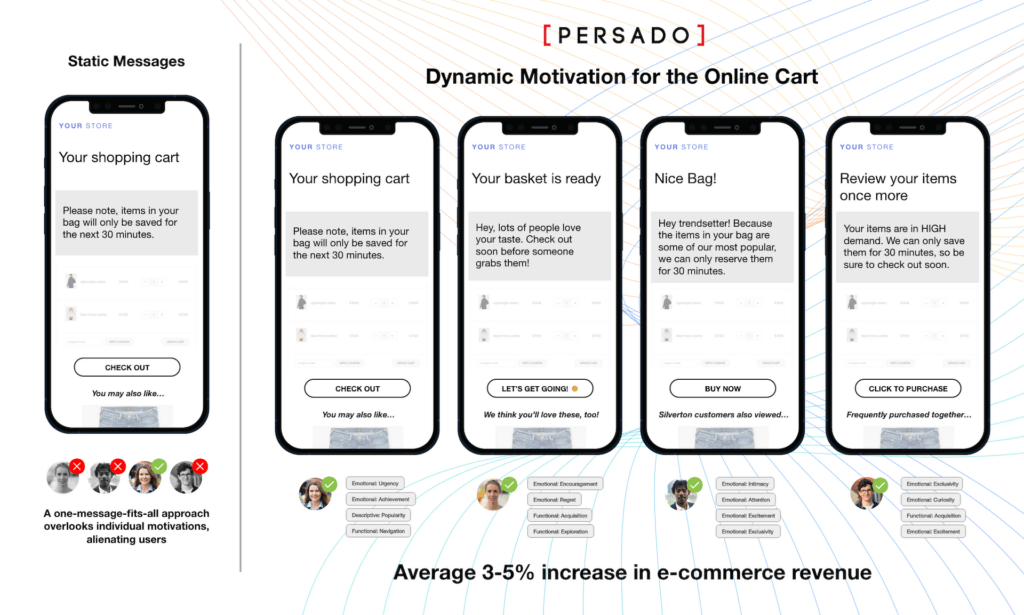October 11, 2023
8 Abandoned Cart Recovery Strategies
By Liza Colburn

Online cart abandonment is an enduring challenge for e-commerce brands. It results in staggering annual revenue losses of $18 billion. Although it’s commonly viewed as a missed sales opportunity, the ramifications of shopping cart abandonment extend far beyond immediate revenue loss. They include reduced return on investment (ROI) on marketing spend, loss of customer lifetime value, lower margins, and more. In this blog, we’ll unveil eight proven abandoned cart recovery strategies that retailers have employed to combat cart abandonment and improve abandoned cart recovery rates.
Your cart abandonment rates are high—look to these abandoned cart recovery strategies
Cart abandonment happens when customers add items to their online shopping carts, but fail to finalize the purchase. This distinction is crucial, as it differs from abandoned checkouts, where customers leave the process further along the checkout journey.
Customers abandon their carts for various reasons, and understanding these factors is crucial for businesses looking to enhance conversion rates. Common issues contributing to cart abandonment include unexpected costs like shipping fees or taxes, complex checkout processes, external distractions, comparison shopping on other websites, mandatory account creation, poor return policies, technical difficulties, and more.
To counter these challenges, businesses should prioritize abandoned cart recovery strategies, which yield substantial benefits.
Combat cart abandonment: 8 abandoned cart recovery strategies to implement
1. Personalized language in the online cart
- While brands have invested in personalization across the digital shopping journey, the online cart, where sales are made, is left static and unchanged.
- Persado Dynamic Motivation uses session data along with Generative AI and our Motivation AI knowledge base to deliver personalized messaging in the online cart to motivate each customer to complete their purchase, anonymized or not.
- E-commerce brands that use Dynamic Motivation in the online cart as part of their abandoned cart recovery strategy have the potential to increase online revenue by 3-5%.
- According to the 2023 1Gartner® Use-Case Prism: Generative AI for Marketing report, “Improvements in personalization can shorten sales cycles, increase conversion rates, raise customer satisfaction, reduce churn and support customer advocacy.”

2. Cart abandonment emails
- Cart abandonment emails are a tried-and-true abandoned cart recovery strategy. When a customer leaves items in their cart without completing the purchase, send them a reminder email.
- One study found that 60% of shoppers returned to make a purchase within 24 hours of receiving a personalized follow-up email.
- Best practices for abandoned cart email templates include catchy subject lines, creating urgency with terms like “hurry” or “only two left.” Learn more on how to use Generative AI for email marketing subject lines.
- Email marketing automation tools make it easy to create and send automated abandoned cart recovery email campaigns customized for different audience segments.
3. Cart saver pop-ups
- To recover more abandoned carts effectively, consider using a cart saver popup. Keep the popup simple and straight to the point, and ensure the offer is enticing enough to encourage sign-ups.
- Show the cart saver popup on exit intent or when a visitor is about to leave your site with items in their cart. This timing is crucial as it catches them in a ‘buying mode,’ increasing the chances of conversion.
- Utilize default trigger settings to display the popup to visitors who meet specific criteria, such as making an exit attempt or having products valued above a certain dollar value in their cart.
- Explore various ways to display the cart saver popup, including showing it on specific pages or when certain products are added to a cart. You can create multiple variations of the popup based on the cart’s value.
- Lastly, decide whether you’ll capture visitors’ email addresses, phone numbers, or both to reveal a discount code. Using a cart-saver popup for email list growth can be valuable in the long run, as each captured email address can potentially yield sales.
4. Social proof and user-generated content
- Utilize user-generated content: Encourage customers to share their photos, videos, or testimonials featuring your products. This authentic content serves as a powerful form of social proof.
- Display customer reviews prominently: Showcase reviews on your product pages, highlighting both positive feedback and constructive criticism. Transparency can build trust. Reviews paired with photos of the product in real life or worn by real customers give potential buyers more confidence in their purchases.
- Highlight star ratings: Use star ratings alongside product listings to provide a quick visual representation of customer satisfaction levels.
- Share success stories: Feature stories or case studies of satisfied customers who achieved significant benefits from your products.
- Implement trust badges: Display trust badges, certifications, or industry awards to reinforce your brand’s credibility and reliability.
- Leverage social media mentions: Share positive mentions and interactions from social media platforms to demonstrate a thriving and engaged customer community.
5. Live chat for last-minute questions
- Sometimes, potential buyers have questions or concerns that prevent them from completing the purchase.
- Live chat offers real-time communication, allowing customers to get immediate answers to their inquiries or resolve concerns without delay.
- Live chat agents or bots can provide personalized recommendations based on the customer’s preferences and needs, enhancing the shopping experience. Learn more on this and other conversational marketing tactics.
6. Urgency (countdown clock)
- People tend to procrastinate, but they also fear missing out. By adding a countdown clock to your cart page or checkout process, you create a sense of urgency.
- Customers are more likely to act when they know a special offer or product availability is limited.
- Leveraging the fear of missing out, a countdown timer taps into the psychological aspect of human behavior, motivating shoppers to complete their purchases to avoid missing a great deal.
- Countdowns can be used for time-sensitive promotions, such as flash sales, holiday discounts, or seasonal offers, encouraging customers to make a decision within the specified timeframe.
7. Clear CTAs and user journey
- Ensure that the path from cart to checkout is clear and straightforward.
- Your calls-to-action (CTAs) should be visually prominent and guide users seamlessly through the checkout process. A complex or confusing user journey can lead to cart abandonment.
- Make sure your website’s navigation menus and buttons are intuitive, with a clear path from the cart to the checkout page. Users should easily find their way to complete the purchase.
- Use visually striking and well-placed CTA buttons that stand out from the rest of the page. “Checkout Now” or “Proceed to Payment” buttons should be easily visible and encourage users to take the next step.
- Simplify the checkout process by minimizing the number of steps required to complete a purchase. Long and complicated checkouts can frustrate users, leading to cart abandonment.
- Offer a guest checkout option that doesn’t require users to create an account. Some shoppers prefer a quicker, anonymous buying process without the hassle of registration.
8. Fair shipping and return policies
- Transparent and fair shipping and return policies can instill confidence in potential buyers. Hidden fees or unclear return processes can deter customers from completing their purchases.
- Clearly display shipping costs during the shopping process, ideally on the product page or in the cart. Avoid surprising customers with high shipping fees during checkout.
- Make your return policy, including the duration within which returns are accepted and any specific conditions or requirements, easily accessible on your website.
- According to the Retail Economics report Battling Basket Abandonment: Mastering Delivery Choice & Convenience, delivery choice can make or break the customer journey. 81% of consumers consider delivery options integral to their decision to shop with a non-food retailer.
Level up your checkout
Abandoned cart recovery strategies should start in the online cart. While most e-commerce brands focus on driving customers to the checkout page, innovation usually stops there. Persado Dynamic Motivation for the online cart leverages Generative AI and our exclusive Motivation AI knowledge base to provide persuasive messaging that encourages shoppers to finalize their purchases.
Qualified retailers can receive a risk-free trial of Dynamic Motivation and start seeing results right away. .
- Gartner, Use-Case Prism: Generative AI for Marketing, 5 October 2023. GARTNER is a registered trademark and service mark of Gartner, Inc. and/or its affiliates in the U.S. and internationally and is used herein with permission. All rights reserved ↩︎


